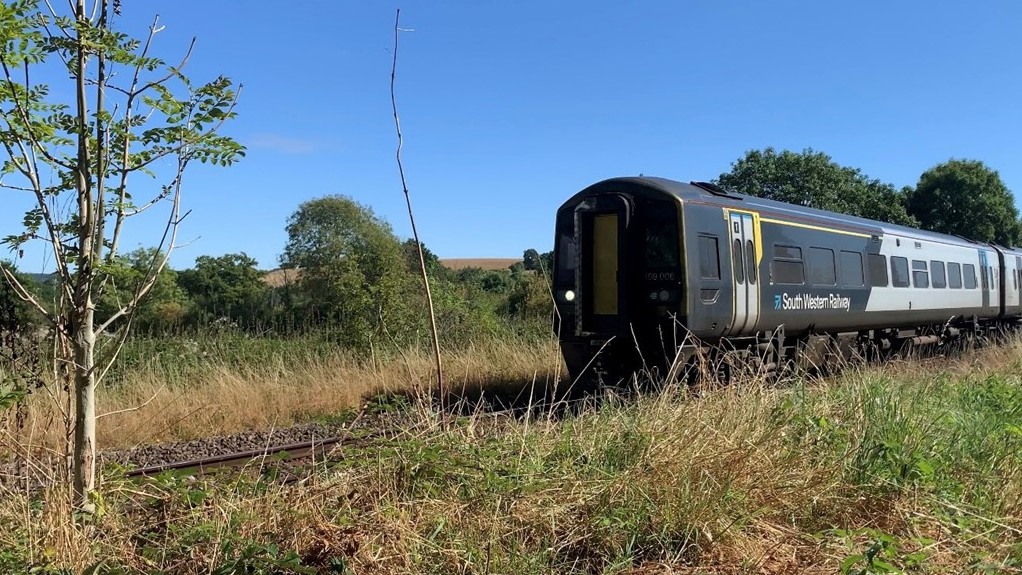Wednesday 26 Oct 2022
Full speed ahead on West of England line as full timetable to be brought back between Salisbury and Exeter St Davids in November
- Region & Route:
- Southern
- | Southern: Wessex
From mid-November, lines between Salisbury and Exeter St Davids will be running at full service.
After two months with fewer trains – and lower speeds – services on the West of England line will return to normal between Salisbury and Exeter St Davids on Monday 14 November.
Speed restrictions of 40mph were brought in at locations near Tisbury, Gillingham and Axminster, as the clay-based track bed shrank in the record-breaking hot and dry summer, leaving the rails uneven and too bumpy for trains to run at full speed.
Since then, engineers have made good progress in restoring the track levels, helped by cooler temperatures and regular rain which has stopped the track bed shrinking. As a result, we are able to lift the speed restrictions and South Western Railway’s (SWR) regular timetable will be restored from Monday 14 November.
Mark Killick, Network Rail’s route director for Wessex, said: “We’re still suffering the after-effects of a record-breaking summer on our railway, but I’m pleased we’ll be able to have trains running at full speed again soon, and I’m so grateful for customers for bearing with us.
“We’ve invested tens of millions of pounds on the West of England Line in the last two years by strengthening railway cuttings and renewing track and switches and crossings. As well as December’s track renewals, we’ve got even more planned in 2023 and 2024, demonstrating our commitment to all of the customers who use this line every year.”
Claire Mann, South Western Railway’s managing director, said: “I am sorry to all those customers whose journeys were affected as we waited for weather conditions to improve to enable Network Rail to safely remove the speed restrictions. We’re looking forward to implementing a full timetable and providing the quality services that our customers deserve."
The cause of the speed restrictions on the line is known as Soil Moisture Deficit and is caused by largely clay-based soils shrinking in hot and dry conditions as trees and other vegetation soaks the water from them. They shrink unevenly, meaning track laid on top loses its level profile.
There are around 6,000 embankments built from clay in the Southern region of Network Rail with a section in Tisbury – 4 miles – is the longest. With only a single track for trains in both directions, any delays caused by running slowly mean services going the other way must wait, and delays are compounded.
In a separate project a month later, engineers will return to this area of the West of England Line to renew track and improve reliability. As there is only one track in the area, it means SWR services between Salisbury and Exeter St Davids will be diverted via Westbury between Saturday 10 and Sunday 18 December while work takes place. Buses will serve Tisbury, Gillingham (Dorset), Templecombe and Sherborne.
The focus of the nine-day closure between Salisbury and Yeovil Junction is to replace track in the Gillingham area. Making the most of the closure, engineers will also make improvements at Gillingham and Sherborne stations; improve drainage in the Sherborne, Templecombe and Gillingham areas; perform track maintenance in the Gillingham and Sherborne areas; and remove graffiti and clean litter from the line at Salisbury.
Further closures are planned in November/December 2023 and March 2024, with the Axminster, Crewkerne, Templecombe and Gillingham areas all set for improvements.
Contact information
Passengers / community members
Network Rail national helpline
03457 11 41 41
Latest travel advice
Please visit National Rail Enquiries
Journalists
Tala Ghannam
Media Relations Manager - National
Network Rail
020 3356 8700
tala.ghannam2@networkrail.co.uk
About Network Rail
We own, operate and develop Britain's railway infrastructure; that's 20,000 miles of track, 30,000 bridges, tunnels and viaducts and the thousands of signals, level crossings and stations. We run 20 of the UK's largest stations while all the others, over 2,500, are run by the country's train operating companies.
Usually, there are almost five million journeys made in the UK and over 600 freight trains run on the network. People depend on Britain's railway for their daily commute, to visit friends and loved ones and to get them home safe every day. Our role is to deliver a safe and reliable railway, so we carefully manage and deliver thousands of projects every year that form part of the multi-billion pound Railway Upgrade Plan, to grow and expand the nation's railway network to respond to the tremendous growth and demand the railway has experienced - a doubling of passenger journeys over the past 20 years.
Follow us on Twitter: @networkrail
Visit our online newsroom: www.networkrailmediacentre.co.uk

